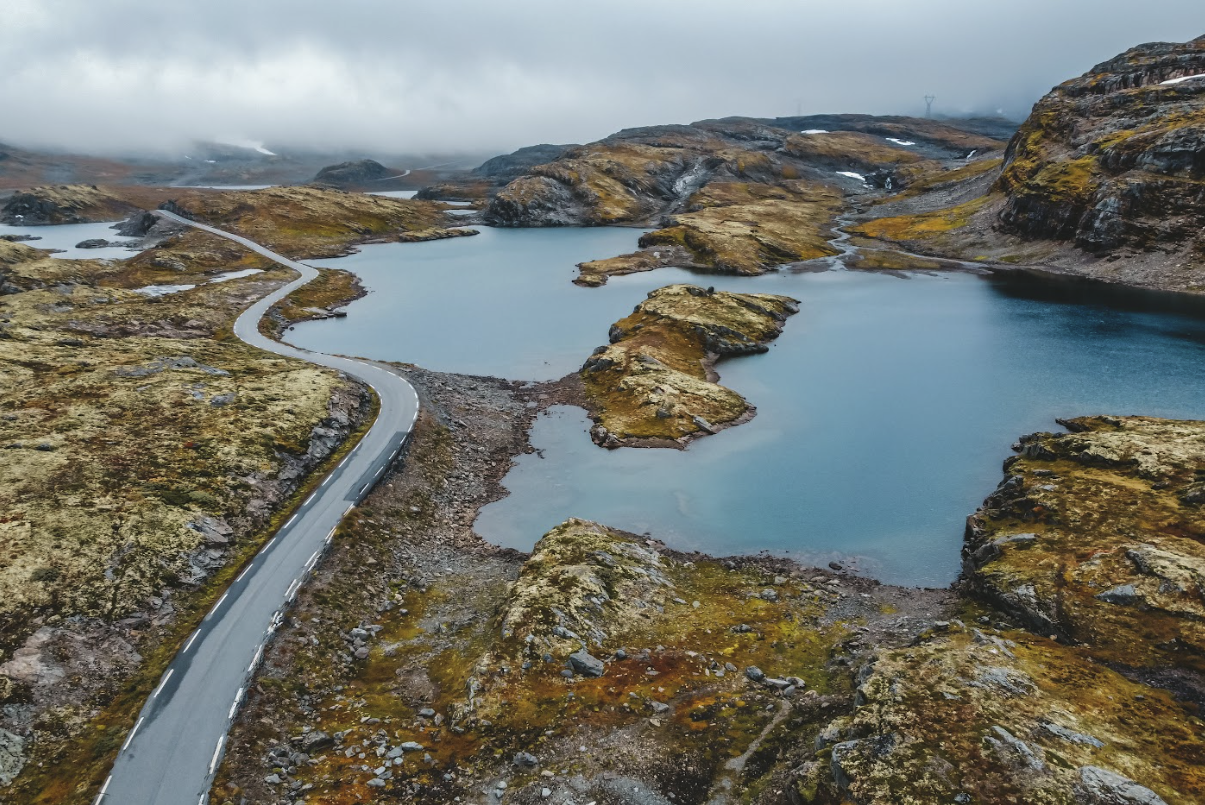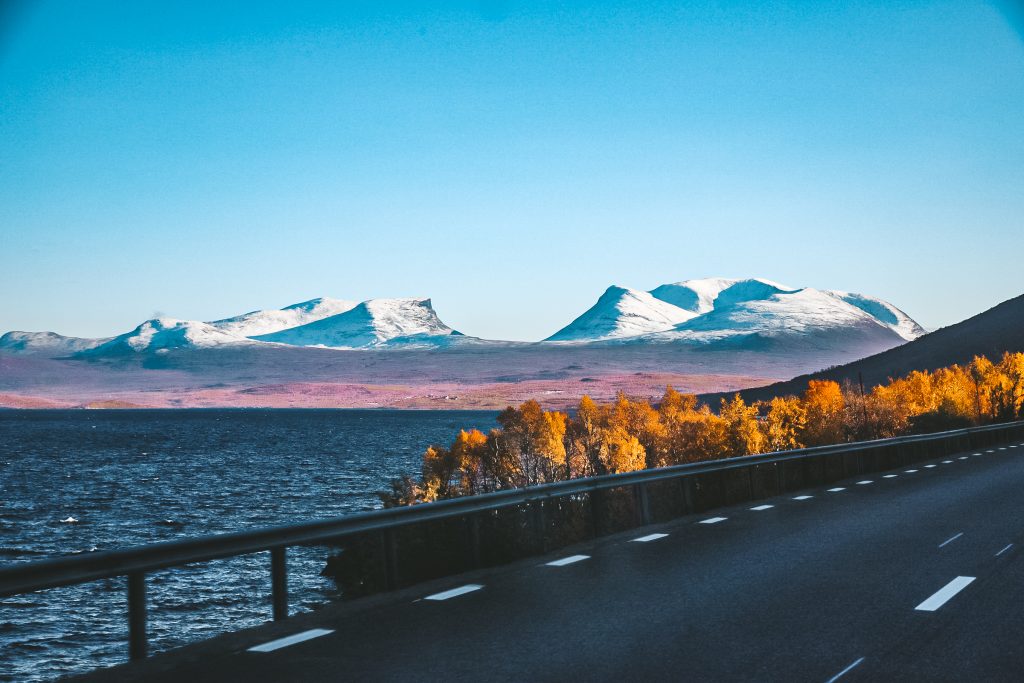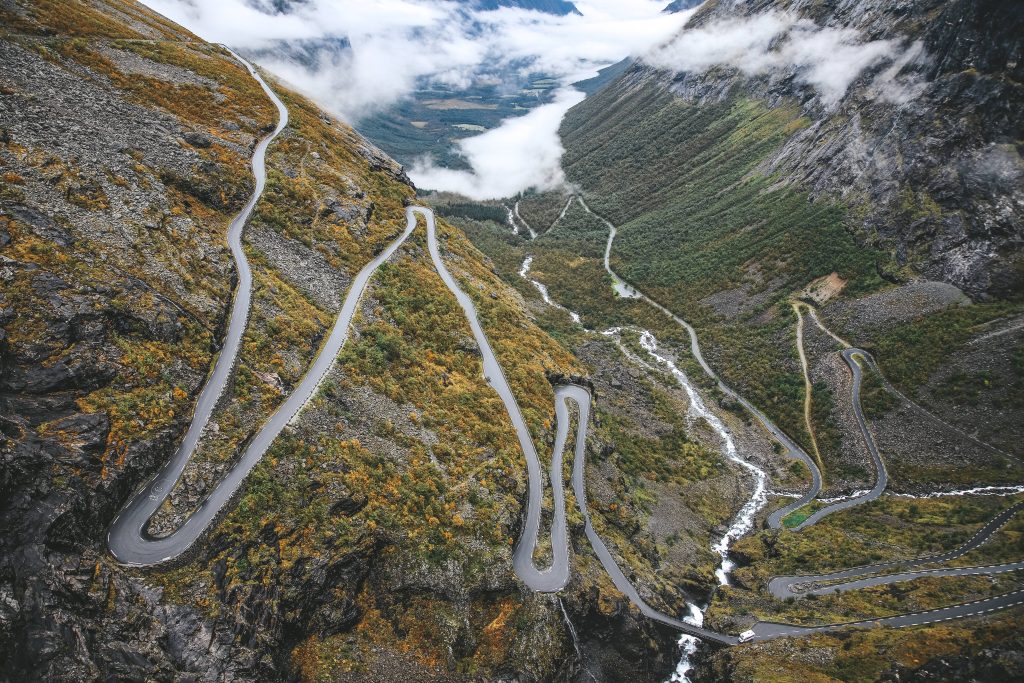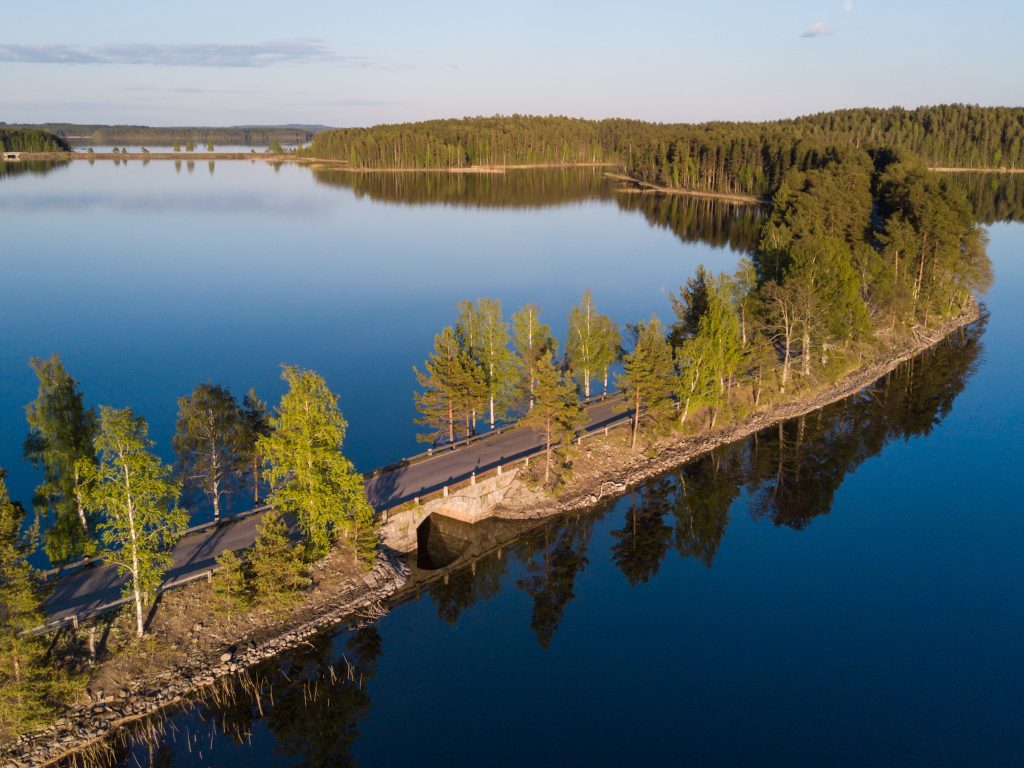50% discount for the first 100 vehicles: Only 10% service fee for one year. Register now!
Toll fees in Scandinavia – Everything you need to know
, Jun 18, 2024, Reading time: 14 min
Reading time: 14 min

• • •
A road trip through Scandinavia’s breathtaking landscape is a dream for many travelers, both for those who live up here and for people from the rest of Europe. Before you set off on the scenic roads, it’s important to keep an eye on the tolls in the Scandinavian countries.
Regardless of whether you are traveling across the country’s borders to Norway, Sweden, Finland, or Denmark, the rules and fees for using motorways, bridges, and tunnels can vary greatly. In this article, we therefore take a closer look at the different fee systems in Scandinavia so that you are well prepared for your camping trip.
Although some of the Scandinavian customs rules may seem complicated at first glance, they are, according to many, the fairest and simplest in all of Europe. You just need to know a few tricks and prepare before your trip. So, let’s take a look at what fees apply, how you pay them, and if there might be a saving tip or two to make the most of your trip in scandinavia
1. Toll fees in Sweden
Tolls on motorways in Sweden
Let me share the good news right up front. There are no tolls on Swedish motorways. You can drive from north to south and from east to west for free, without a vignette or paying at toll stations, which you may know from other European countries, and choose any road you want. However, there are a few exceptions in cities and on bridges.
Swedish cities with congestion tax
That the roads are completely free of tolls is, however, a truth with a modification, because Sweden has a congestion tax. In the two largest Swedish cities, Stockholm and Gothenburg, there is this fee when entering the city center or parts of the city center. For example, if you travel on the E4 into Stockholm, you must pay congestion tax. The sum differs between different times and areas, but applies to all vehicles with a permissible total weight of up to 14 tonnes. The congestion tax must be paid by both the Swedish population and foreign travelers.
The fee is adapted to the day on which you travel, and applies between 06:00 and 18:29. The times of the day with the most traffic are of course the most expensive. In Gothenburg, you only need to pay the congestion charge once every 60 minutes, even if you drive past several toll stations within 60 minutes. Fortunately, there are exceptions to the fee, as it is reduced in the evenings and at night (between 6:30 p.m. and 5:59 p.m.), on weekends and public holidays, and throughout the month of July in Gothenburg and the last three weeks of July in Stockholm. Motorcycles are also exempt from tolls.
You can see how high the fees are in detail in the following table:
| Time | Gothenburg | Stockholm | Essingeleden | ||
| Year-round | Peak season* | Low season* | Peak season* | Low season* | |
| 6.00 – 6.29 | SEK 9 | SEK 15 | SEK 15 | ||
| 6.30 – 6.59 | SEK 16 | SEK 30 | SEK 25 | SEK 27 | SEK 22 |
| 7.00 – 7.59 | SEK 22 | SEK 45 | SEK 35 | SEK 40 | SEK 30 |
| 8.00 – 8.29 | SEK 16 | SEK 45 | SEK 35 | SEK 40 | SEK 30 |
| 8.30 – 8.59 | SEK 9 | SEK 30 | SEK 25 | SEK 27 | SEK 22 |
| 9.00 – 9.29 | SEK 9 | SEK 20 | SEK 15 | SEK 20 | SEK 15 |
| 9.30 – 14.59 | SEK 9 | SEK 11 | SEK 11 | ||
| 15.00 – 15.29 | SEK 16 | SEK 20 | SEK 15 | SEK 20 | SEK 15 |
| 15.30 – 15.59 | SEK 22 | SEK 30 | SEK 25 | SEK 27 | SEK 22 |
| 16.00 – 16.59 | SEK 22 | SEK 45 | SEK 35 | SEK 40 | SEK 30 |
| 17.00 – 17.29 | SEK 16 | SEK 45 | SEK 35 | SEK 40 | SEK 30 |
| 17.30 – 17.59 | SEK 16 | SEK 30 | SEK 25 | SEK 27 | SEK 22 |
| 18.00 – 18.29 | SEK 9 | SEK 20 | SEK 15 | SEK 20 | SEK 15 |
| 18.30 – 5.59 | free | free | free | ||
| Maximum charge per day | SEK 60 | High season / Holiday times | |||
| SEK 135 / SEK 105 | |||||
* Low season: 1 to 28/29 December, February, and Midsummer until 14 August
Sources: The Swedish Transport Agency
Payment of the congestion tax in Sweden
The tolls do not have to be paid directly on the spot but are paid afterward. The vehicle’s registration number is photographed, after which the owner of the vehicle is identified. The tolls you have to pay are collected during the month and add up to a final invoice that is sent at the end of the month. This invoice must be paid by the stated due date at the latest to avoid additional costs.
With a rental vehicle, you can also register with Epass24. This way you can see the toll costs incurred and pay by direct debit. Be sure to deregister after your trip, otherwise, you may also be responsible for the costs for the next person renting the vehicle!
Paid bridges in Sweden
There are only four bridges in Sweden at which toll fees are incurred. Otherwise, it’s free!
Fee for Öresundsbron
The Öresund bridge connects Denmark with Sweden, making it the perfect way to get between the countries with your camping vehicle, up and down across the continent.
Payment of these tolls can be made on the spot in cash or by credit card, as well as in advance online or via transponder, so-called BroBizz. By purchasing an online ticket, it is possible to pass the toll station without stopping because you have registered the vehicle’s registration number in advance. With ØresundGO you can also get away cheaper.
For payment on the spot, it is smart to check the receipt to ensure the correct classification of the vehicle and keep it. If the vehicle had happened to be incorrectly classified, you can fix it later. In the table below, you’ll see how much it costs to cross the bridge. The information is stated in SEK and DKK, but not EUR. To get an idea of how much SEK corresponds to in EUR, you may just divide the sum by 10.
| Vehicle | ØresundGO | Regular price |
| Passenger car (max 6m) | SEK 263 | SEK 885 |
| Passenger car (max 6m) with trailer (max 15m) | SEK 526 | SEK 1 370 |
| Passenger car (max 6m) with trailer (over 15m) | SEK 1 055 | SEK 2 405 |
| Motorhome (6-10m) | SEK 526 | SEK 1 370 |
| Motorhome (over 10m) | SEK 1 055 | SEK 2 405 |
| Motorhome (over 6m) with trailer | SEK 1 055 | SEK 2 405 |
| Minibus and van (6-10m) | SEK 526 | SEK 1 370 |
Source: https://www.oresundsbron.com/en/prices
As you can see, it can be worth taking a look at getting a subscription with Øresund GO. It will cut the price of crossing the bridge by more than half. The annual cost of the subscription is SEK 539, but you have quickly earned these in total on two bridge crossings.
Bridge tolls for the Motala, Sundsvalls and Skuru bridges
The Motala Bridge on lake Vättern, the Sundsvall Bridge on the Baltic coast in Västernorrland County, and the Skuru Bridge, which connects Stockholm with Nacka and Värmdö, are also tolled. For these three bridges, the payment system works in the same way as the congestion charge in Stockholm and Gothenburg, which means invoicing afterward (via Epass24 for foreign license plates). The fees are the same all year round and apply 24 hours a day. The fees convert to between EUR 0.35 and EUR 0.77, so it’s quite cheap.
| Vehicle | Motala | Sundsvall | Skuru |
| Cars up to 3.5 tonnes | SEK 5 | SEK 9 | SEK 4 |
| Motorcycle | free | free | free |
Source: The Swedish Transport Agency
This might also interest you
If you plan a camping holiday in Scandinavia, you may be looking for a suitable itinerary through Sweden. On MyCamper, you can also find the right camping vehicle for your trip in Sweden!

Rent the perfect camping vehicle for you and start your own camping trip.
Rent a motorhomeRent a campervanRent a caravan2. Toll fees in Norway
New roads, tunnels, and bridges in Norway
The toll system in Norway is quite cleverly thought out, as newly built traffic routes, tunnels, and bridges are financed through tolls. The good thing here is that the tolls are only paid until the construction costs are covered. This is usually the case after a few years after which the passage or crossing is free. However, this also results in a fairly substantial change in fees and it is easy to quickly lose track of what applies, making the budgeting a challenge. But as soon as you approach a zone where you have to pay a fee, you will see blue signs with a camera symbol, which will inform you of the amount.
Also worth mentioning is that the fee system in Norway is flexible and less expensive than you are otherwise used to in Norway.
Pay road tolls in Norway
As in Sweden, invoicing is handled via automatic registration of license plates. This means that you can keep driving smoothly during your road trip, without having to stop at more or less manual toll stations. For vehicles that are not registered in Norway, invoicing takes place via an invoice, which is sent with Epass24 (Park Trade Europe AB) by post.
Before starting your trip, you can register your rental vehicle with a foreign license plate online via Epass24. Registering and creating a user account is easy, but not mandatory. However, this allows you to receive invoices by email, manage them online, view due dates, and make payments. Alternatively, you can pay the invoice amount directly online by credit card.
Note: Epass24 is only used for foreign license plates. The fees for vehicles registered in Norway are invoiced directly via the country’s road toll company.
Another payment option is the AutoPAss chip, which is useful for longer stays in Norway. You can find information about it here.
Norwegian cities with tolls
Another special feature in Norway is the toll for roads in cities, which must be paid for the following 14 cities and regions: Ålesund, Askøy, Bergen, Bodø, Førde, Grenland, Harstad, Haugesund, Kristiansand, Nedre Glomma, Nord-Jæren, Oslo, Tromsø, and Trondheim. For vehicles and campers up to 3.5 tonnes, between 13 and 66 Norwegian kroner (NOK) are charged per toll section. This converts to between EUR 1 and EUR 6.
Now, let’s have a look at a smart saving tip. If you avoid rush hours Monday to Friday between 06:30 and 09:00 and 14:30 and 17:00 in Bergen, Grenland, Kristiansand, Oslo, Tromsø, and Trondheim, you can save up to 50 % on road tolls.
Payment of the city tax in Norway
Again, you have the advantage that payment for driving in Norwegian cities is made in the same toll system as on all Norwegian roads. There is also an opportunity to save some money in Bergen, Kristiansand, and Oslo, as low-emission vehicles are subject to toll discounts in these cities. The basic rule is that petrol, hybrid, electric, and hydrogen vehicles must pay less than diesel vehicles. To use this savings tip, you must enter information about the vehicle’s environmental aspects at Epass24.
Plan for tolls in Norway in advance
When it comes to these tolls in Norway, how do I know approximately what costs await me during my camping trip? There are intelligent online tools that calculate your tolls (plus any ferry costs) for your planned route in advance. Brilliant, isn’t it?An example of this is the fee calculator from Fremtind Service. You can use the basic version without an account, and according to our experience, the service works very well. Here, you can enter your starting point and destination, travel date, and vehicle details, after which you will receive different routes with distance information and tolls. This gives you a perfect starting point for planning your travel expenses and you can see at a glance which route you might want to avoid to save money.
This may also interest you
If you are going camping in Norway, you do of course also need the perfect travel route! We also have everything else you need to know before your camping trip in Norway, which we summarized in this article. Get inspired!
Here, you will find the right camper for you in Norway!

3. Toll fees in Denmark
Let’s share some good news. In Denmark, the southernmost Scandinavian country, you don’t have to pay any tolls on the motorways. There are also no congestion charges or similar in cities in Denmark. Having said that, you don’t need to count on any tolls at this destination, apart from the bridge toll on the Öresund Bridge. More about that now!
Paid bridges in Denmark
If your road trip takes you across the Great Belt Bridge alternatively in or out of Sweden, across the Öresund Bridge, those are the only road tolls you pay in Denmark.
Toll for the Great Belt Bridge
In order to comfortably commute between the two Danish islands of Zealand and Funen in your camping vehicle, you have been able to use the more than 13-kilometer-long Great Belt Bridge since 1998. European route E20 leads from Knudshoved on the island of Funen via the island of Sprogø and finally to Halsskov on the island of Zealand and back.
At the payment station, there are three different colored lanes that you can choose when paying. Via the yellow lane, you can pay with cash. You can pay in euros, but you will get the change back in DKK. Via the blue lane, you can only pay by credit card. The green lane is for automatic payment via transponder or license plate. As you usually don’t use the bridge too often during your trip (probably a maximum of two times), payment on the spot (yellow or blue file) is the easiest option.
| Vehicle | Price includes all persons for a one-way trip in Danish kroner (DKK) |
| Passenger cars (max 3 m) | 420 DKK |
| Passenger cars with a caravan | 420 DKK |
| Van (max 6m) | 275 DKK |
| Motorhome (max 10m) | 620 DKK |
| Motorhome (over 10 m) | 985 DKK |
Source: https://storebaelt.dk/en/prices-and-discounts/private/
Toll for the Öresund Bridge
You will find all the information about the Öresund Bridge, which connects Denmark with Sweden, in the first section, but here under the Danish section, we present it in DKK.
| Vehicle | ØresundGO | Regular price |
| Passenger car (max 6m) | DKK 175 | DKK 455 |
| Passenger car (max 6m) with trailer (max 15m) | DKK 350 | DKK 910 |
| Passenger car (max 6m) with trailer (over 15m) | DKK 701.25 | DKK 1,600 |
| Motorhome (6-10m) | DKK 350 | DKK 910 |
| Motorhome (over 10m) | DKK 701.25 | DKK 1,600 |
| Motorhome (over 6m) with trailer | DKK 701.25 | DKK 1,600 |
| Minibus and van (6-10m) | DKK 350 | DKK 910 |
Source: https://www.oresundsbron.com/sv/priser
This may also interest you
When planning your road trip through Denmark, the right itinerary is a must. In this article, we have summarized what else you need to know for your camping holiday in Denmark.
For unique overnight spots on your road trip, you can be inspired by our tips on the North Sea coast or the most beautiful campsites for families.
Here, you will find the right camper for Denmark!

4. Toll fees in Finland
And what about when you go to eastern Scandinavia, to Finland? Here, the following applies: drive wherever and as far as you want, enjoy your road trip, and experience the beautiful destination – completely free! That’s right, you don’t have to worry about road tolls at all. With that said, the first place for the cheapest and easiest Scandinavian country when it comes to tolls goes to Finland!
This may also interest you
If you would like to travel to Finland in a camper, you might still be looking for the right travel route. If so, we have summarized everything you need to know for your Finnish camping trip in this article.
Here, you will find the right camper for Finland!

Rent the perfect camping vehicle for you and start your own camping trip.
Rent a motorhomeRent a campervanRent a caravan5. Conclusion
Although Scandinavia is generally known for its higher travel costs, you don’t need to spend a lot of money on toll fees. On the contrary, in a European context, Norway, Sweden, Denmark, and Finland are among the cheaper places when it comes to tolls.
Another advantage is that there are no typical toll stations in Scandinavia – apart from some bridges – where large traffic jams form during holiday periods. The toll system, with invoicing based on license plates or transponders, works so smoothly that you don’t even notice it.
Although it is cheap, there is one thing that is extra important to keep in mind – you should of course always pay the tolls on time. Otherwise, there is a risk of fines, after which the low costs suddenly aren’t that low anymore.

Newest articles
No articles found